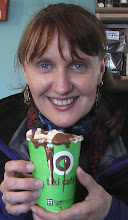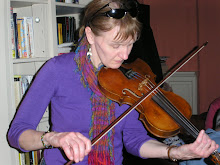Day 1 Glasgow
April 10, 2012
This group includes travellers from CA, ID, CO, MN, MI, IA and FL. For some it is their first time out of North America. Others are regularly on the road. We have a wide mix of backgrounds from a sheep rancher, to professors, computer technologists, accountant, and avid volunteers. There are individual travellers, and several couples. Two women, once on the tour, discovered they graduated from the same class at the same high school!
Our first stop wa s House for an Art Lover. The house was designed over 100 years ago by Charles Renne Mackintosh for a contest to design a house for an art lover. He submitted his entry under the pseudonym "Der Vogel" and indeed throughout the house, you find motifs of birds. He did not win the competition. But in 1980, two businessmen decided his house should be built. And in 1996, the house, in Bellahouston Park, in Glasgow, opened.
s House for an Art Lover. The house was designed over 100 years ago by Charles Renne Mackintosh for a contest to design a house for an art lover. He submitted his entry under the pseudonym "Der Vogel" and indeed throughout the house, you find motifs of birds. He did not win the competition. But in 1980, two businessmen decided his house should be built. And in 1996, the house, in Bellahouston Park, in Glasgow, opened.
 s House for an Art Lover. The house was designed over 100 years ago by Charles Renne Mackintosh for a contest to design a house for an art lover. He submitted his entry under the pseudonym "Der Vogel" and indeed throughout the house, you find motifs of birds. He did not win the competition. But in 1980, two businessmen decided his house should be built. And in 1996, the house, in Bellahouston Park, in Glasgow, opened.
s House for an Art Lover. The house was designed over 100 years ago by Charles Renne Mackintosh for a contest to design a house for an art lover. He submitted his entry under the pseudonym "Der Vogel" and indeed throughout the house, you find motifs of birds. He did not win the competition. But in 1980, two businessmen decided his house should be built. And in 1996, the house, in Bellahouston Park, in Glasgow, opened. The clean lines and the influence of nature inside the house was influenced by Mackintosh's appreciation of Japanese design. Throughout the home the "Mackintosh Rose" symbol appears again and again. Margaret Macdonald, Charle's wife, a fine artist, designed the gesso plaqu
The clean lines and the influence of nature inside the house was influenced by Mackintosh's appreciation of Japanese design. Throughout the home the "Mackintosh Rose" symbol appears again and again. Margaret Macdonald, Charle's wife, a fine artist, designed the gesso plaqu es and the stipling on the wall . When the house was built, students from the Glasgow School of Art and other area artisans recreated the furniture, cabinets, stained glass, virtually the entire interior as the Mackintosh's designed it 100 years ago.
es and the stipling on the wall . When the house was built, students from the Glasgow School of Art and other area artisans recreated the furniture, cabinets, stained glass, virtually the entire interior as the Mackintosh's designed it 100 years ago.Charles died in 1928, poor and virtually forgotten, and Margaret died in 1932. Their marriage was a true love story. Today, people world wide value the design aesthetic we today call "Mackintosh" There are many other sites in the Glasgow area that feature the architecture and interiors of Charles Mackintosh. The House for an Art Lover might be a good place to start.
 |
| Tulips in the walled garden outside of House for an Art Lover |
Liz Gibson, an enthusiastic volunteer docent, guided us through the tapestries and embroideries on display. The collection includes large and small tapestries from Flanders, Brussels, and France. Most of the tapestries are currently not displayed as the museum is in the process of cataloguing and studying them for a scholarly publication.
“Four Scenes from the Life of a A Virgin” was woven in Switzerland in the late 1400's and woven for the church. It has wonderful little details like the fact that the angel's eyes
 were woven cross-eyed!
were woven cross-eyed!
“Four Scenes from the Life of a A Virgin” was woven in Switzerland in the late 1400's and woven for the church. It has wonderful little details like the fact that the angel's eyes

 were woven cross-eyed!
were woven cross-eyed!
Large tapestries were woven in Flanders and France. Brussels was a major weaving center in the 1500's. By this time the royalty were commissioning most of the tapestries. Henry VIII was reported to own over 2000 tapestries. “Prudence Arriving at the Temple of the Divine Wisdom” approximately 5 x 12 meters, was woven on its side w hich made it much stronger when hanging. The weavers sat side by side following a cartoon. They only had 2 dozen colours of yarn at that time, so they used a hatching technique which created 3rd colour from two yarn colours and added dimension to the figures.
hich made it much stronger when hanging. The weavers sat side by side following a cartoon. They only had 2 dozen colours of yarn at that time, so they used a hatching technique which created 3rd colour from two yarn colours and added dimension to the figures.
 hich made it much stronger when hanging. The weavers sat side by side following a cartoon. They only had 2 dozen colours of yarn at that time, so they used a hatching technique which created 3rd colour from two yarn colours and added dimension to the figures.
hich made it much stronger when hanging. The weavers sat side by side following a cartoon. They only had 2 dozen colours of yarn at that time, so they used a hatching technique which created 3rd colour from two yarn colours and added dimension to the figures.
Burrell also collected 350 embroideries. English embroideries were the best of the day during the Stewart and Tudor periods. Men and women could earn a tremendous wage in the profession. Mary Queen of Scots was an amazing embroiderer. I could not take photos of the embroideries due to low light.
Walking around the park, which has a large herd of Highland cattle, flowers, and trees, is a green peaceful retreat in the middle of the largest city in Scotland.http:/www.glasgowlife.org.uk/museums/our-museums/burrell-collection/Pages/home.aspx
Walking around the park, which has a large herd of Highland cattle, flowers, and trees, is a green peaceful retreat in the middle of the largest city in Scotland.http:/www.glasgowlife.org.uk/museums/our-museums/burrell-collection/Pages/home.aspx
Subscribe to: Posts (Atom)










No comments:
Post a Comment